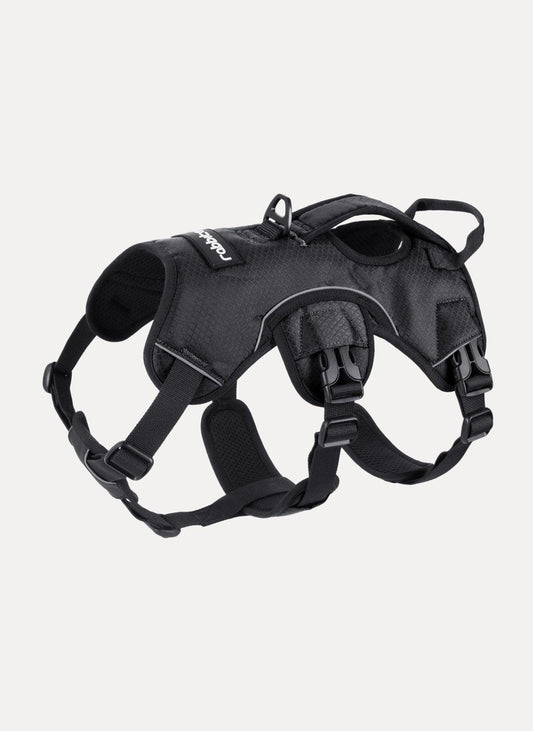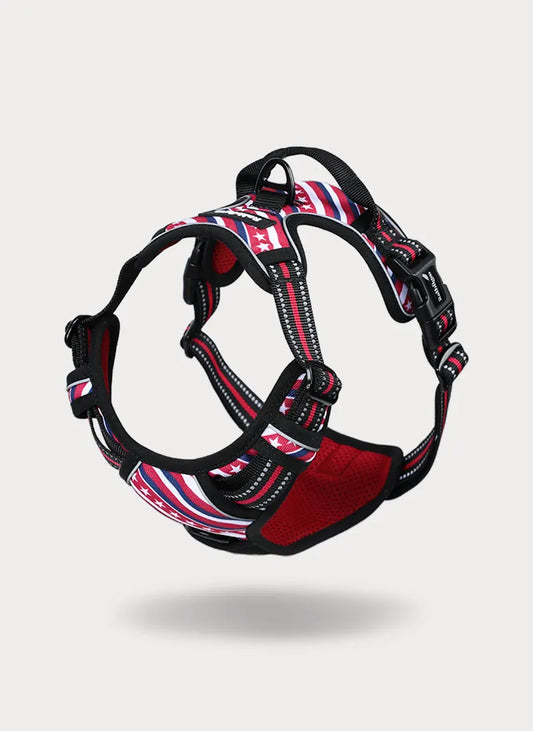A Guide to the Types of Service Dogs
Service dogs are wonderful companions that are trained to assist people with disabilities in various ways. From guiding the blind to detecting allergens and alerting the seizures, these service dogs provide vital support and enhance independence. In this blog, you’ll learn about the various types of service dogs, their specific roles, and how they contribute to the lives of their handlers. Let’s get started.
1. Guide Dogs
Guide digs are specifically trained to assist people who are blind or visually impaired. These dogs typically wear a special service dog harness with handle for their owner to grasp. These service dogs help their handlers by guiding them around obstacles, indicating changes in elevation like stairs, and stopping at curbs.
They are taught to follow directional commands but they also make choices based on their own assessment of a situation. The relationship between a guide dog and the handler is built on trust and mutual understanding. These service dogs enable their handlers to move safely and confidently, improving their mobility and overall quality of life. Most commonly used guide dog breeds include Labradors, Golden Retrievers, and German Shepherds.
2. Signal Dogs (Hearing dogs)
Signal dogs, also called hearing dogs, are trained to assist individuals who are deaf or hard of hearing. These dogs recognize and alert their handler to numerous sounds and environmental cues like alarm clocks, doorbells, door knocking, phone ring bells, smoke alarms, and even the person’s name.
When signal dogs hear a certain cue, they alert their owner and lead them toward the source of the sound. These dogs increase their partners’ independence and allow them to navigate their surroundings more safely and effectively.
Signal dogs typically wear a distinctive, comfortable service dog harness that identifies them as service animals. Common breeds used as service dogs include Labradors, Golden Retrievers, Poodles, and Cocker Spaniels.
3. Mobility Assistance Animals
Mobility assistance dogs are trained to assist physically disabled people with mobility issues. These dogs are typically partnered with people who are in wheelchairs or have arthritis, brain injuries, spinal cord injuries, cerebral palsy, and muscular dystrophy. Some mobility assistance dogs are particularly trained for people with balance issues.
Individuals with disabilities rely on mobility assistance dogs to help them perform routine tasks. This includes opening doors, retrieving objects, turning on lights, pressing automatic door and elevator buttons, and helping with transfers to beds, chairs, or bathtubs. They may wear a service dog mobility harness that helps them assist their owner.
Larger breeds such as Golden Retrievers, Labradors, Samoyeds, and Border Collies are suitable for these jobs as mobility assistance dogs need to be strong enough to assist their handlers.
4. Allergy Detection Dogs
Allergy detection dogs are specially trained to detect the slightest traces of allergens in their environment. These allergens include gluten, peanuts, eggs, or other substances that could trigger an allergic reaction. Allergy detection dogs can pick up the scent of an allergen before their owner even comes into contact with it.
Allergy detection dogs are often paired with kids because they are more likely to have severe allergies than adults. This provides children with increased independence and gives their parents greater comfort and security. These dogs undergo specialized training to detect specific scents associated with allergens and alert their handlers through specific behaviors or signals.
Most allergy detection dogs wear service dog harness with pockets for medical information and medication, in the event of an emergency.
5. Psychiatric Service Dogs
Psychiatric service dogs can provide emotional support to people suffering from mental health disorders. These dogs are specifically trained to help people with anxiety, depression, and post-traumatic stress disorder (PTSD). They’re able to sense a change in their human when they’re about to experience an anxiety attack or a painful flashback.
People with mental disorders often have a tough time leaving their homes or taking care of themselves. They may experience intense feelings of discomfort or panic attacks in public settings. Psychiatric service dogs help provide a comforting barrier during panic attacks and in times of distress. They can perform numerous tasks, including turning on lights before their handler enters a room and protecting their handler’s personal space to make them feel safer.
6. Seizure Alert Dogs
Seizure alert dogs assist individuals before, during, and after a seizure. They’re trained to detect the onset of seizures in their owners and alert them or others to the impending seizure. Once they detect these signs, they may alert their handler by nudging, licking, or behaving unusually. This early warning allows the handler to prepare for a seizure, take necessary precautions, such as sitting down or moving to a safer place, enhancing their safety and well-being during seizures.
These dogs undergo specialized training to recognize specific pre-seizure cues or changes in their handler's behavior or scent, enabling them to effectively perform their life-saving role. Scientists and medical experts have different opinions on training seizure alert dogs. Some believe dogs can be trained for this purpose, while others think dogs naturally sense seizures based on intuition and their bond with their human partners.
7. Diabetic Alert Dogs
Diabetic alert dogs are specifically trained to alert their owner to blood sugar highs (hyperglycemia) and lows (hypoglycemia). When the dog alerts, the person knows to test their blood and inject insulin or ingest glucose to adjust their levels. The diabetic alert dogs provide a sense of independence and security to their owners.
Diabetic alert dogs are typically also trained to alert other people in the household or set off an alarm if their person needs medical assistance. Some dogs are even trained to call 911 on a special K-9 alert phone if they’re home alone. These dogs should also carry emergency protocols in their vests so first responders know how to proceed.
8. Autism Service Dogs
Autism service dogs can be life-changing partners and act as constant companions to people with autism. They help autistic people to improve social interactions and gain confidence and independence. They are trained to help people navigate social settings.
Many individuals with autism have trouble forming connections with their peers and reading social cues. Autism service dogs can provide comfort and a sense of predictability for people with autism. These dogs improve their communication skills and help them better regulate their emotions.
Autism service dogs are often paired with children with autism. They can act as a social bridge and make for the perfect icebreaker. Kids with autism are more likely to run away or wander off. The autism service dog can keep track of them, protect them, and alert parents when their child is in a dangerous situation.
Final Thoughts
If you see a service dog when you are out in public, you must remember it has a job to do and should not be distracted. Also, keep in mind that not all disabilities and illnesses are obvious. Some people with a service dog may seem perfectly capable, but these dogs are necessary for helping them function normally.
When considering a service dog harness, the Rabbitgoo service dog harness with handle is a great choice. It offers useful features designed to improve both the comfort of the service dog and the effectiveness of their role.









